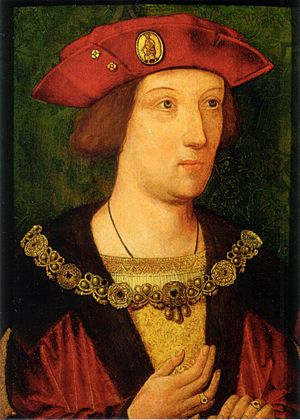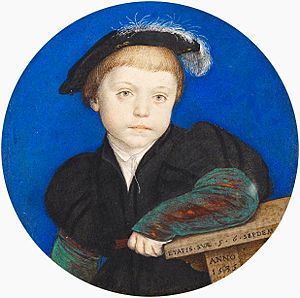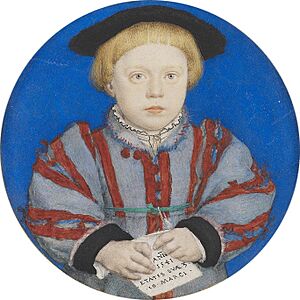Sweating sickness facts for kids
Quick facts for kids Sweating sickness |
|
|---|---|
| Synonyms | English sweating sickness, English sweat, (Latin) sudor anglicus |
 |
|
| Illustration by the Virgil Master depicting the sweating sickness | |
| Symptoms | chills, body pains, weakness |
| Causes | Unknown |
Sweating sickness, also called the sweats or English sweat, was a strange and very contagious illness. It appeared in England and then in other parts of Europe. This disease caused several outbreaks, starting in 1485.
Major outbreaks happened in 1508, 1517, and 1528. The last one was in 1551. After that, the disease seemed to disappear completely. Symptoms came on very suddenly. People often died within hours of getting sick.
Sweating sickness was different from other diseases of its time. Other outbreaks usually happened in cities and lasted a long time. But the sweats appeared and vanished quickly. It also affected people in the countryside a lot. We still don't know what caused it. Some scientists think it might have been a type of hantavirus.
Contents
What Were the Symptoms?
A doctor named John Caius saw an outbreak in 1551. He wrote a book about the disease. This book is our main source of information.
The sickness started very suddenly. People felt worried, then had cold shivers. These shivers could be very strong. They also felt dizzy and had headaches. There were severe pains in the neck, shoulders, and arms. People felt very tired.
This cold stage could last from 30 minutes to three hours. After that, the hot and sweating stage began. A lot of sweat would suddenly appear for no clear reason. People felt very hot and had headaches. Their hearts beat fast, and they were very thirsty. Heart pain was also common.
Doctors did not see any skin rashes. In the final stages, people either became very weak or felt a strong urge to sleep. Dr. Caius believed sleeping could be deadly. Getting the disease once did not make you immune. Some people got sick several times before they died. The illness usually lasted about one full day before recovery or death. It tended to happen in summer and early autumn.
Another doctor, Thomas Forestier, wrote about his experience in 1485. He noted that people often had sudden breathing problems. He thought "bad vapors" gathered around the heart and lungs. This suggests the disease affected the lungs.
How Did It Spread?
How the disease spread is still a mystery. We only have a few clues from old writings. The sweating sickness affected people from all walks of life. It hit people in the countryside and working-class people hard. But it also infected young, strong men, including those from rich families.
Records show that men aged 30-40 were most likely to die from it. Because it infected everyone, rich or poor, it got nicknames like "Stoop Gallant." This meant that even proud, high-ranking people had to face their own weakness.
Many people were in London for the crowning of Henry VII. This large gathering might have helped the disease spread faster. It could have also spread other germs through the air.
What Caused It?
The exact cause of sweating sickness is still unknown. People at the time, and even now, have blamed bad sewage, poor hygiene, and dirty water. The first confirmed outbreak was in August 1485. This was at the end of the Wars of the Roses. Some thought French soldiers might have brought it from France.
However, there might have been an earlier outbreak in York in June 1485. This was before Henry Tudor's army landed. But the descriptions of that illness are not clear enough to be sure.
Other Ideas for the Cause
- Relapsing fever: This disease is spread by ticks and lice. It often happens in summer, like the sweats. But relapsing fever causes a black scab and a rash, which were not seen with sweating sickness.
- Ergot poisoning: This was ruled out. England did not grow much rye, which is the main cause of ergotism.
- Hantavirus: Researchers have noticed that symptoms of sweating sickness are similar to hantavirus pulmonary syndrome. Hantaviruses are carried by bats, rodents, and some insectivores. The way hantavirus spreads matches some patterns of the sweats. For example, both often happen in certain seasons. Also, hantavirus usually affects middle-aged adults, not babies, children, or the elderly. This was also true for the English sweating sickness.
- A problem with this idea is that modern hantaviruses don't just disappear. Also, hantaviruses rarely spread from person to person. But some hantavirus outbreaks in Argentina have shown human-to-human spread.
- Anthrax: In 2004, a scientist suggested it might have been anthrax poisoning. He thought people could have gotten sick from anthrax spores in raw wool or dead animals. He suggested digging up victims to test them.
Scientists have tried to find the disease's origin using modern biology. But they haven't found any DNA or RNA from the disease.
History of Outbreaks



The First Outbreak (1485)
Doctors first noticed sweating sickness in 1485. This was at the start of King Henry VII's rule. It was often deadly. In some areas, half the people died.
Some historians think King Richard III might have gotten sick the night before the Battle of Bosworth Field. This could explain why he couldn't sleep and was very thirsty during the battle.
Henry VII arrived in London on August 28, 1485. The disease broke out there on September 19. By late October, it had killed thousands of people. This included two lord mayors and many other important officials.
People became very scared and suspicious. The Battle of Bosworth Field ended the Wars of the Roses. King Richard III was killed, and Henry VII became king. As people felt chaos and anger, they looked for someone to blame. Some English people believed God sent the plague to punish Henry VII's supporters.
People saw the sweats as very different from the Black Death. It was known for how quickly it killed and the intense sweating.
The disease reached Ireland in 1492. Records there mention the death of James Fleming, 7th Baron Slane from the "perspiring plague." Other Irish records also mention an "unusual plague" that lasted 24 hours. People who survived past 24 hours usually recovered. It did not affect babies or young children.
An English writer, Richard Grafton, wrote about the 1485 outbreak. He noted that the common treatment was to go straight to bed. People were told to stay completely still for 24 hours. They should not eat solid food and drink very little water.
Later Outbreaks (1500s)

The illness was not recorded between 1492 and 1502. It might have been the sickness that affected Henry VII's son, Arthur, Prince of Wales. Arthur and his wife, Catherine of Aragon, got sick in March 1502. Their illness was called "a bad vapor from the air." Catherine recovered, but Arthur died on April 2, 1502. He was almost 16 years old.
A second, smaller outbreak happened in 1507. Then came a third, much worse one in 1517. A few cases might have spread to Calais, which was English territory then. In 1517, the disease seemed to affect English people more. A visitor from Venice noted that very few foreign visitors got sick.
A similar pattern was seen in 1528. Calais had an outbreak, but it did not spread into France. The 1528 outbreak was the fourth major one. It spread across most of England, but not the far north. It also reached Ireland. Many people died in London. King Henry VIII left London and often changed where he lived. In 1529, Thomas Cromwell lost his wife and two daughters to the disease.
It is believed that several people close to Henry VIII caught the sickness. His letters show that doctors thought his future wife, Anne Boleyn, had it. Henry sent his best doctor to help her, and she survived. Cardinal Wolsey also got sick but recovered.
The disease reached Hamburg, Germany, in July 1529, brought by a ship from England. It spread along the Baltic coast. It went north to Denmark, Sweden, and Norway. It also went south to cities like Strasbourg and Cologne. In each place, it lasted only a short time, usually less than two weeks. By the end of 1529, it had disappeared from mainland Europe. It did not return there.
The Last Major Outbreak (1551)
The last big outbreak of sweating sickness in England was in 1551. It started in Shrewsbury in April. About 1,000 people died there. It quickly spread across the rest of England. By October, it had almost disappeared. It was more common among younger men. This might be because they were more active in society.
John Caius wrote his eyewitness account of this outbreak. Henry Machyn also wrote about it in his diary:
the vii day of July begane a nuw swet in London…the x day of July [1551] the Kynges grace removyd from Westmynster unto Hamtun courte, for ther [died] serten besyd the court, and caused the Kynges grase to be gone so sune, for ther ded in London mony marchants and grett ryche men and women, and yonge men and old, of the new swett…the xvi day of July ded of the swet the ii yonge dukes of Suffoke of the swet, both in one bed in Chambrydge-shyre…and ther ded from the vii day of July unto the xix ded of the swett in London of all dyssesus… [872] and no more in alle
—The Diary of Henry Machyn 1550–1563
The records for Halifax Parish show 44 deaths in 1551. An outbreak called 'sweating sickness' happened in Tiverton in 1644. It killed 443 people. However, this was much later than the accepted end of the English sweating sickness in 1551. So, it might have been a different illness.
Picardy Sweat
Between 1718 and 1918, an illness similar to the English Sweat appeared in France. It was called the Picardy sweat. It was not as deadly as the English Sweat. But it happened very often, with about 200 outbreaks recorded.
Some experts noted a "great similarity" between the two diseases. Picardy sweat also caused intense sweating and fever. One doctor, Henry Tidy, believed they were the same disease.
However, there were also clear differences. Picardy sweat came with a rash, which was not seen in the English disease. Henry Tidy thought that maybe the English cases were so fast and deadly that a rash didn't have time to appear.
Picardy sweat seemed to affect people differently. Those who slept close to the ground or lived on farms were more likely to get it. This supports the idea that the disease could be carried by rodents, like hantaviruses. In a 1906 outbreak of Picardy sweat, scientists believed fleas from field mice caused the infection.

